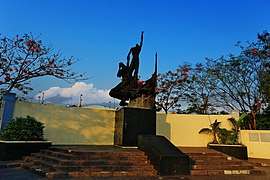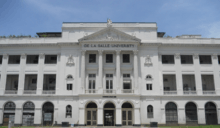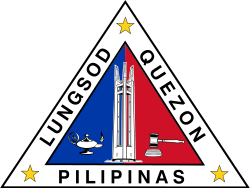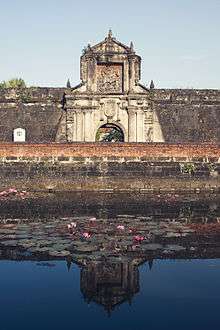Metro Manila
Metropolitan Manila[1][6] (often shortened as Metro Manila; Tagalog: Kalakhang Maynila), officially the National Capital Region (NCR), is the seat of government and one of three defined metropolitan areas in the Philippines. It is composed of 16 cities: the city of Manila, Quezon City, Caloocan, Las Piñas, Makati, Malabon, Mandaluyong, Marikina, Muntinlupa, Navotas, Parañaque, Pasay, Pasig, San Juan, Taguig, and Valenzuela, as well as the municipality of Pateros. The region encompasses an area of 619.57 square kilometers (239.22 sq mi) and a population of 12,877,253 as of 2015.[3] It is the second most populous and the most densely populated region of the Philippines. It is also the 9th most populous metropolitan area in Asia and the 5th most populous urban area in the world.
Metro Manila Kalakhang Maynilà Kamaynilaan Metropolitan Manila | |
|---|---|
| National Capital Region (NCR) | |
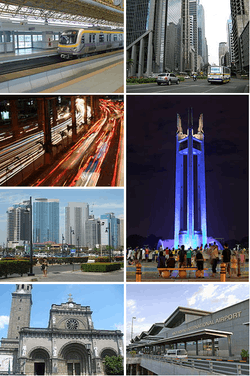 Clockwise (from upper right): Ayala Avenue, Quezon Memorial Shrine, NAIA Terminal 3, Manila Cathedral, Bonifacio Global City, Epifanio de los Santos Avenue, J. Ruiz station | |
 Location in the Philippines | |
| Coordinates: 14.58°N 121°E | |
| Country | |
| Island | Luzon |
| Managing entity | Metropolitan Manila Development Authority |
| Established | November 7, 1975[1] |
| Composed of | |
| Government | |
| • Type | Metropolitan government under decentralized framework[2] |
| • Body | Metropolitan Manila Development Authority |
| • MMDA Chairman | Danilo Lim (LP) |
| • Metro Manila Mayor Council Chairman | Edwin Olivarez (PDP-Laban) |
| Area | |
| • Metropolitan area and region | 619.57 km2 (239.22 sq mi) |
| Population (2000 census)[3] | |
| • Metropolitan area and region | 12,877,253 |
| • Density | 21,000/km2 (54,000/sq mi) |
| • Metro | 24,100,000 (agglomeration not, metropolitan area) |
| Demonyms | English: Manilan; Spanish: manilense,[lower-alpha 1] manileño(-a) Tagalog: Manileño(-a), Manilenyo(-a), Taga-Maynila |
| Time zone | UTC+8 (PST) |
| IDD : area code | +63 (0)2 |
| ISO 3166 code | PH-00 |
| GDP (2016) | ₱5.52 trillion $108.36 billion[5] |
| Growth Rate | |
| Police | PNP NCRPO |
| HDI | |
| HDI rank | 2nd (2015) |
| Website | www |
| |
The region is the center of culture, economy, education and government of the Philippines. Designated as a global power city, the region exerts a significant impact on commerce, finance, media, art, fashion, research, technology, education, and entertainment, both locally and internationally. It is the home to all the consulates and embassies in the Philippines, thereby making it an important center for international diplomacy in the country. Its economic power makes the region the country's premier center for finance and commerce. The region accounts for 37.2% of the gross domestic product of the Philippines.[7]
The region was established in 1975 through Presidential Decree No. 824 in response to the needs to sustain the growing population and for the creation for the center of political power and the seat of the Government of the Philippines.[8] The Province of Manila, the predecessor entity of the region, is one of the first eight provinces that revolted against the Spanish colonial rule in the Philippines at the end of the 19th century. Manila's role in the Revolution is honored in the Flag of the Philippines, where the sun's eight rays symbolize the eight revolutionary provinces.
History
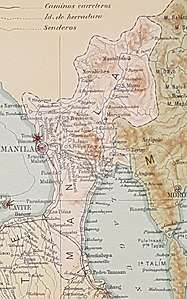
A historical province known as Manila encompassed territories once held by various pre-Hispanic polities. This included the well-known Pasig River delta settlements of Maynila and Tondo, but smaller settlements such as those at Tambobong, Taguig, Pateros, and the fortified polity of Cainta. It became the capital of the colonial Philippines, with Manila (Intramuros) serving as the center of colonial power. In 1898, it included the City of Manila and 23 other municipalities. Mariquina also served as the capital from 1898–1899, just as when the sovereignty of the Philippines was transferred to the United States. The province was dissolved and most of it was incorporated into the newly created province of Rizal in 1901.
Since the Spanish colonial period, Manila was considered as one of the original global cities. The Manila galleon was the first known commercially traveled trade route that sailed the Pacific for 250 years, bringing to Mexico their cargoes of luxury goods, economic benefits, and cultural exchange.
During the American period, at the time of the Philippine Commonwealth, American architect and urban designer Daniel Burnham was commissioned to create the grand Plan of Manila to be approved by the Philippine Government. The creation of Manila in 1901 was composed of the places and parishes of Binondo, Ermita, Intramuros, Malate, Manila, Pandacan, Quiapo, Sampaloc, San Andrés Bukid, San Fernando de Dilao, San Miguel, San Nicolas, Santa Ana de Sapa, Santa Cruz, Santa Mesa and Tondo. Meanwhile, the towns and parishes of Caloocan, Las Piñas, Mariquina, Pasig, Parañaque, Malabon, Navotas, San Juan del Monte, San Pedro de Macati, San Felipe Neri, Muntinlupa and the Taguig-Pateros area were incorporated into the province of Rizal, with Pasig being designated as its provincial capital.

In 1939, President Quezon established Quezon City with a goal to replace Manila as the capital city of the country. A master plan for Quezon City was completed. The establishment of Quezon City meant the demise of the grand Burnham Plan of Manila, with funds being diverted for the establishment of the new capital. World War II further resulted in the loss of most of the developments in the Burnham Plan, but more importantly, the loss of more than 100,000 lives at the Battle of Manila in 1945. Later on, Quezon City was eventually declared as the national capital in 1948. The title was re-designated back to Manila in 1976 through Presidential Decree No. 940, owing to its historical significance as the almost uninterrupted seat of government of the Philippines since the Spanish colonial period. Presidential Decree No. 940 states that Manila has always been, to the Filipino people and in the eyes of the world, the premier city of the Philippines, being the center of trade, commerce, education, and culture.[9]
During the war, President Manuel L. Quezon created the City of Greater Manila as an emergency measure, merging the cities of Manila and Quezon City, along with the municipalities of Caloocan, Las Piñas, Mariquina, Pasig, Parañaque, Malabon, Navotas, San Juan del Monte, San Pedro de Macati, San Felipe Neri, Muntinlupa and the Taguig-Pateros area. Jorge Vargas was appointed as its mayor. Mayors in the cities and municipalities included in the City of Greater Manila served as vice mayors in their town. This was in order to ensure that Vargas, who was Quezon's principal lieutenant for administrative matters, would have a position of authority recognized under international military law. The City of Greater Manila was abolished by the Japanese with the formation of the Philippine Executive Commission to govern the occupied regions of the country. The City of Greater Manila served as a model for the present-day Metro Manila and the administrative functions of the Governor of Metro Manila that was established during the Marcos administration.
On November 7, 1975, Metro Manila was formally established through Presidential Decree No. 824. The Metropolitan Manila Commission was also created to manage the region.[8] On June 2, 1978, through Presidential Decree No. 1396, the metropolitan area was declared the National Capital Region of the Philippines.[10] When Metro Manila was established, there were four cities, Manila, Quezon City, Caloocan, Pasay and the thirteen municipalities of Las Piñas, Makati, Malabon, Mandaluyong, Marikina, Muntinlupa, Navotas, Parañaque, Pasig, San Juan, Taguig, Valenzuela and Pateros. At present, all but one of these municipalities have become independent chartered cities; only Pateros still remains as a municipality.

President Ferdinand Marcos appointed his wife, First Lady Imelda Marcos, as the first governor of Metro Manila. She launched the City of Man campaign. The Cultural Center of the Philippines Complex, Metropolitan Folk Arts Theater, Philippine International Convention Center, Coconut Palace and healthcare facilities such as the Lung Center of the Philippines, Philippine Heart Center, and the Kidney Center of the Philippines are all constructed precisely for this purpose. President Marcos was overthrown in a non-violent revolution along EDSA, which lasted four days in late February 1986. The popular uprising, now known as the People Power Revolution, made international headlines as "the revolution that surprised the world".[11]
In 1986, President Corazon Aquino issued Executive Order No. 392, reorganizing and changing the structure of the Metropolitan Manila Commission and renamed it to the Metropolitan Manila Authority. Mayors in the metropolis chose from among themselves the chair of the agency. Later on, it was again reorganized in 1995 through Republic Act 7924, creating the present-day Metropolitan Manila Development Authority. The chairperson of the agency will be appointed by the President and should not have a concurrent elected position such as mayor. Former Laguna province governor Joey Lina was the last to serve as the Officer-In-Charge governor of Metro Manila.[12]
By late 2014, then-MMDA Chairman Francis Tolentino proposed that San Pedro, Laguna be included in Metro Manila as its 18th member city. Tolentino said that in the first meeting of the MMDA Council of mayors in January 2015, he will push for the inclusion of the city to the MMDA.[13] Senator Aquilino "Koko" Pimentel III filed Senate Bill No. 3029, which seeks to create San Pedre as a separate legislative district to commence in the next national and local elections if the bill was passed into law.[14][15]
The region has been placed under a community quarantine since March 15, 2020 due to the COVID-19 pandemic.[16]
Geography
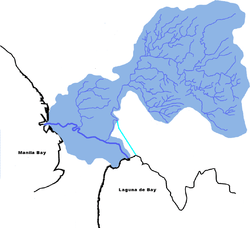
Metro Manila is located in the southwestern portion of Luzon. The region lies along the flat alluvial lands extending from the mouth of the Pasig River in the west to the higher rugged lands of Marikina Valley in the east. The region is geographically divided into 4 zones: the Coastal Margin, Guadalupe Plateau, Marikina Valley, and the Laguna Lowlands. The Coastal Margin that faces the Manila Bay possesses resources for offshore fisheries and fishpond development. The various reclamation projects in the area are meant for mixed-use urban development. The Guadalupe Plateau is the most adaptable to urban development activities not only because of its solid geographical foundations but also because of its existing infrastructure links with the rest of Luzon. The Marikina Valley has fertile land suitable for crop cultivation while the Marikina River provides water for industrial uses and discharge. The Laguna Lowlands is not only suitable for agriculture and aquaculture but also for industrial activity.[17]
Natural hazards
Metro Manila is exposed to multiple natural hazards such as earthquakes, floods, and typhoons. It is surrounded by active faults including the Marikina Valley Fault System. Other distant faults such as the Philippine Faults, Lubang Faults, Manila Trench and Casiguran Faults, are a threat as well.[18] Flooding is recurrent every year especially in low-lying areas. Around five to seven typhoons hit Manila yearly. Manila was ranked as the second riskiest capital city after Tokyo to live in according to Swiss Re.[19]
Climate
According to the Köppen climate classification, there are two climates in Metro Manila. Most of the region has a tropical wet and dry climate (Köppen climate classification Aw) while the northeastern part of the region that lies on the foothills of Sierra Madre has a tropical monsoon climate. Together with the rest of the Philippines, Manila lies entirely within the tropics. Its proximity to the equator means that temperatures are hot year-round, rarely going below 15 °C or above 39 °C. Temperature extremes have ranged from 14.4 °C on January 11, 1914,[20] to 38.5 °C on May 7, 1915.[21]
Humidity levels are usually very high all year round. Manila has a distinct dry season from December through April, and a relatively lengthy wet season that covers the remaining period with slightly cooler temperatures. In the wet season, it rarely rains all day, but rainfall is very heavy during short periods. Typhoons usually occur from June to September.[22]
| Climate data for Port Area, Manila (1981–2010, extremes 1885–2012) | |||||||||||||
|---|---|---|---|---|---|---|---|---|---|---|---|---|---|
| Month | Jan | Feb | Mar | Apr | May | Jun | Jul | Aug | Sep | Oct | Nov | Dec | Year |
| Record high °C (°F) | 36.5 (97.7) |
35.6 (96.1) |
36.8 (98.2) |
38.0 (100.4) |
38.6 (101.5) |
37.6 (99.7) |
36.5 (97.7) |
35.6 (96.1) |
35.3 (95.5) |
35.8 (96.4) |
35.6 (96.1) |
34.6 (94.3) |
38.6 (101.5) |
| Average high °C (°F) | 29.6 (85.3) |
30.6 (87.1) |
32.1 (89.8) |
33.5 (92.3) |
33.2 (91.8) |
32.2 (90.0) |
31.2 (88.2) |
30.8 (87.4) |
31.0 (87.8) |
31.1 (88.0) |
30.9 (87.6) |
29.8 (85.6) |
31.3 (88.3) |
| Daily mean °C (°F) | 26.7 (80.1) |
27.4 (81.3) |
28.7 (83.7) |
30.1 (86.2) |
30.0 (86.0) |
29.3 (84.7) |
28.5 (83.3) |
28.3 (82.9) |
28.4 (83.1) |
28.4 (83.1) |
28.0 (82.4) |
27.0 (80.6) |
28.4 (83.1) |
| Average low °C (°F) | 23.8 (74.8) |
24.2 (75.6) |
25.3 (77.5) |
26.6 (79.9) |
26.9 (80.4) |
26.4 (79.5) |
25.9 (78.6) |
25.8 (78.4) |
25.7 (78.3) |
25.7 (78.3) |
25.1 (77.2) |
24.2 (75.6) |
25.5 (77.9) |
| Record low °C (°F) | 14.5 (58.1) |
15.6 (60.1) |
16.2 (61.2) |
17.2 (63.0) |
20.0 (68.0) |
20.1 (68.2) |
19.4 (66.9) |
18.0 (64.4) |
20.2 (68.4) |
19.5 (67.1) |
16.8 (62.2) |
15.7 (60.3) |
14.5 (58.1) |
| Average rainfall mm (inches) | 17.3 (0.68) |
14.2 (0.56) |
15.8 (0.62) |
23.7 (0.93) |
147.2 (5.80) |
253.5 (9.98) |
420.5 (16.56) |
432.4 (17.02) |
355.1 (13.98) |
234.8 (9.24) |
121.7 (4.79) |
67.4 (2.65) |
2,103.6 (82.82) |
| Average rainy days (≥ 0.1 mm) | 4 | 3 | 3 | 4 | 10 | 17 | 21 | 21 | 20 | 17 | 12 | 7 | 139 |
| Average relative humidity (%) | 72 | 69 | 67 | 66 | 71 | 76 | 79 | 81 | 80 | 78 | 75 | 74 | 74 |
| Mean monthly sunshine hours | 177 | 198 | 226 | 258 | 223 | 162 | 133 | 133 | 132 | 158 | 153 | 152 | 2,105 |
| Source 1: PAGASA[23][24] | |||||||||||||
| Source 2: Danish Meteorological Institute (sun, 1931–1960)[25] | |||||||||||||
| Climate data for Pasay (Ninoy Aquino International Airport) 1981–2010, extremes 1947–2012 | |||||||||||||
|---|---|---|---|---|---|---|---|---|---|---|---|---|---|
| Month | Jan | Feb | Mar | Apr | May | Jun | Jul | Aug | Sep | Oct | Nov | Dec | Year |
| Record high °C (°F) | 35.8 (96.4) |
35.1 (95.2) |
36.5 (97.7) |
37.8 (100.0) |
38.1 (100.6) |
38.0 (100.4) |
36.0 (96.8) |
35.2 (95.4) |
34.9 (94.8) |
36.0 (96.8) |
35.8 (96.4) |
34.2 (93.6) |
38.1 (100.6) |
| Average high °C (°F) | 30.2 (86.4) |
31.0 (87.8) |
32.5 (90.5) |
34.1 (93.4) |
33.8 (92.8) |
32.5 (90.5) |
31.3 (88.3) |
30.8 (87.4) |
31.0 (87.8) |
31.1 (88.0) |
31.1 (88.0) |
30.2 (86.4) |
31.6 (88.9) |
| Daily mean °C (°F) | 26.1 (79.0) |
26.7 (80.1) |
28.0 (82.4) |
29.5 (85.1) |
29.7 (85.5) |
28.8 (83.8) |
28.0 (82.4) |
27.7 (81.9) |
27.8 (82.0) |
27.7 (81.9) |
27.4 (81.3) |
26.5 (79.7) |
27.8 (82.0) |
| Average low °C (°F) | 22.0 (71.6) |
22.5 (72.5) |
23.6 (74.5) |
25.0 (77.0) |
25.5 (77.9) |
25.1 (77.2) |
24.6 (76.3) |
24.6 (76.3) |
24.6 (76.3) |
24.3 (75.7) |
23.7 (74.7) |
22.7 (72.9) |
24.0 (75.2) |
| Record low °C (°F) | 14.8 (58.6) |
14.6 (58.3) |
16.0 (60.8) |
18.7 (65.7) |
19.1 (66.4) |
20.0 (68.0) |
18.3 (64.9) |
17.4 (63.3) |
19.1 (66.4) |
18.0 (64.4) |
17.2 (63.0) |
16.3 (61.3) |
14.6 (58.3) |
| Average rainfall mm (inches) | 6.8 (0.27) |
4.2 (0.17) |
4.0 (0.16) |
16.0 (0.63) |
70.4 (2.77) |
265.2 (10.44) |
316.7 (12.47) |
418.4 (16.47) |
255.2 (10.05) |
283.4 (11.16) |
99.0 (3.90) |
28.6 (1.13) |
1,767.8 (69.60) |
| Average rainy days (≥ 0.1 mm) | 2 | 1 | 1 | 1 | 6 | 14 | 16 | 19 | 16 | 14 | 8 | 3 | 101 |
| Average relative humidity (%) | 75 | 72 | 68 | 67 | 72 | 77 | 81 | 83 | 83 | 80 | 78 | 76 | 76 |
| Source: PAGASA[26][27] | |||||||||||||
| Climate data for Science Garden, Quezon City (1981–2010, extremes 1961–2012) | |||||||||||||
|---|---|---|---|---|---|---|---|---|---|---|---|---|---|
| Month | Jan | Feb | Mar | Apr | May | Jun | Jul | Aug | Sep | Oct | Nov | Dec | Year |
| Record high °C (°F) | 34.7 (94.5) |
35.6 (96.1) |
36.8 (98.2) |
38.0 (100.4) |
38.5 (101.3) |
38.0 (100.4) |
36.2 (97.2) |
35.8 (96.4) |
35.4 (95.7) |
35.4 (95.7) |
35.0 (95.0) |
34.7 (94.5) |
38.5 (101.3) |
| Average high °C (°F) | 30.6 (87.1) |
31.7 (89.1) |
33.4 (92.1) |
35.0 (95.0) |
34.7 (94.5) |
33.1 (91.6) |
31.9 (89.4) |
31.3 (88.3) |
31.6 (88.9) |
31.6 (88.9) |
31.4 (88.5) |
30.5 (86.9) |
32.2 (90.0) |
| Daily mean °C (°F) | 25.7 (78.3) |
26.3 (79.3) |
27.8 (82.0) |
29.4 (84.9) |
29.7 (85.5) |
28.8 (83.8) |
28.0 (82.4) |
27.8 (82.0) |
27.8 (82.0) |
27.6 (81.7) |
27.1 (80.8) |
26.0 (78.8) |
27.7 (81.9) |
| Average low °C (°F) | 20.8 (69.4) |
20.9 (69.6) |
22.1 (71.8) |
23.7 (74.7) |
24.7 (76.5) |
24.6 (76.3) |
24.1 (75.4) |
24.2 (75.6) |
24.0 (75.2) |
23.5 (74.3) |
22.7 (72.9) |
21.6 (70.9) |
23.1 (73.6) |
| Record low °C (°F) | 15.5 (59.9) |
15.1 (59.2) |
14.9 (58.8) |
17.2 (63.0) |
17.8 (64.0) |
18.1 (64.6) |
17.7 (63.9) |
17.8 (64.0) |
20.0 (68.0) |
18.6 (65.5) |
15.6 (60.1) |
15.1 (59.2) |
14.9 (58.8) |
| Average rainfall mm (inches) | 18.5 (0.73) |
14.6 (0.57) |
24.8 (0.98) |
40.4 (1.59) |
186.7 (7.35) |
316.5 (12.46) |
493.3 (19.42) |
504.2 (19.85) |
451.2 (17.76) |
296.6 (11.68) |
148.8 (5.86) |
78.7 (3.10) |
2,574.4 (101.35) |
| Average rainy days (≥ 0.1 mm) | 4 | 3 | 4 | 5 | 12 | 18 | 22 | 23 | 22 | 18 | 14 | 8 | 153 |
| Average relative humidity (%) | 76 | 73 | 69 | 67 | 72 | 79 | 83 | 84 | 84 | 83 | 82 | 79 | 78 |
| Source: PAGASA[28][29] | |||||||||||||
Cityscapes




Parks

There are two national parks in Metro Manila which is managed by the National Parks and Development Committee (NPDC), the Rizal Park and Paco Park in the City of Manila. NPDC used to manage Fort Santiago in Intramuros and the Quezon Memorial National Park in Quezon City. A tripartite agreement between the Quezon City Government, the National Historical Institute and the NPDC transferred the management of Quezon Memorial National Park to the Quezon City Government while the maintenance of Fort Santiago was transferred to Intramuros Administration.[30] The region has three protected areas, namely the Rizal Park, Ninoy Aquino Parks & Wildlife Center and the Manila Bay Beach Resort.[31]
Rizal Park, also known as Luneta Park, is considered as the largest urban park in Asia with an area of 58 hectares (140 acres).[32] The park along with the historic walled area of Intramuros are designated as flagship destination to become a tourism enterprise zone according to the Tourism Act of 2009.[33] Paco Park is a recreational garden which was once the city's municipal cemetery built by the Dominicans during the Spanish colonial period.[34] Filipino Landscape Architect IP Santos, the "Father of Philippine Landscape Architecture", was commissioned to do the design of converting the former cemetery into a park.
Manila Zoo is the oldest zoo in Asia, which was founded on 1959. It is the home to more than a thousand animals from different 90 species including the 40-year-old elephant, Mali. The zoo has an average of 4,000 visitors weekly. An estimated 40,000 tourists visits the zoo each month.[35]
La Mesa Ecopark is a 33-hectare well-developed sanctuary around the La Mesa Watershed. It was established through a joint partnership between the Metropolitan Waterworks and Sewerage System, ABS-CBN, and the Quezon City Government. La Mesa Ecopark, along with the Ninoy Aquino Parks & Wildlife Center, are important nature reserves in the Philippines.
The Las Piñas-Parañaque Critical Habitat and Ecotourism Area (LPPCHEA) was declared as a critical habitat by the Government of the Philippines in 2007[36] and was listed by the Ramsar Convention as a Wetland of International Importance in 2013.[37] LPPCHEA is composed of the Freedom Island in Parañaque and the Long Island in Las Piñas that covers 175 hectares and features a mangrove forest of eight species, tidal mudflats, secluded ponds with fringing salt-tolerant vegetation, a coastal lagoon, and a beach.[38]
Government and politics
.jpg)
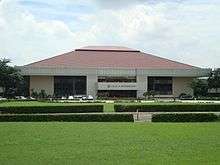
.jpg)
The Metropolitan Manila Development Authority (MMDA) is the agency responsible for the delivery of public services in Metro Manila. Its services are limited to traffic management and garbage collection. Previously Metro Manila was governed by a regional government authority, the Metro Manila Commission and was led by a governor.
A bill was introduced in 2014 proposing the creation of a new governing body in Metro Manila to be known as the Metropolitan Manila Regional Administration (MMRA). Unlike the MMDA which is limited to being an administrative coordinating body, the proposed MMRA will have police and other typical municipal powers and is more akin to the Bangsamoro Autonomous Region in Muslim Mindanao.[39][40]
Metro Manila, the National Capital Region, is the seat of the national government. All the main offices of the executive departments of the country are in Metro Manila. The Department of Agrarian Reform, Department of Agriculture, Department of Environment and Natural Resources, National Housing Authority and Philippine Coconut Authority has their main offices based around Quezon Memorial Circle in Quezon City.
Manila, the capital city of the country, is the home to Malacañan Palace, the official residence and office of the President of the Philippines. The city is also the home to the Supreme Court of the Philippines. Other key national institutions based in Manila are the Court of Appeals, the Bangko Sentral ng Pilipinas, and the Departments of Budget and Management, Finance, Health, Justice, Labor and Employment and Public Works and Highways. Meanwhile, the Department of Science and Technology is based in Taguig while the Department of Tourism has its headquarters in Makati. Important economic and financial institutions headquartered in the region are the Asian Development Bank, Bangko Sentral ng Pilipinas, Development Bank of the Philippines, Land Bank of the Philippines and the National Economic and Development Authority.
The main office of the Government Service Insurance System in Pasay serves as home to the Senate of the Philippines. Meanwhile, the House of Representatives of the Philippines is based in the Batasang Pambansa Complex, Quezon City along with the Sandiganbayan. The Coconut Palace once served as the official office and residence of the Vice President of the Philippines in 2010–2016. The Quezon City Reception House has been serving this purpose since 2016.
Local Government Units
The political and administrative boundaries of the National Capital Region has not changed since its formation in 1975 as a public corporation under Presidential Decree No. 824. They are composed of sixteen independent cities, classified as highly urbanized cities, and one independent municipality: Pateros.
 Primary local government units of Metro Manila, 2019
|
| ||||||||||||||||||||||||||||||||||||||||||||||||||||||||||||||||||||||||||||||||||||||||||||||||||||||||||||||||||||||||||||||||||||||||||||||||||||||||||||||||||||||||
Districts
Unlike other administrative regions in the Philippines, Metro Manila is not composed of provinces. Instead, the region is divided into four geographic areas called "districts."[44] The districts have their district centers at the four original cities in the region: the city-district of Manila (Capital District), Quezon City (Eastern Manila), Caloocan (Northern Manila, also informally known as Camanava), and Pasay (Southern Manila).[45] The districts serve mainly to organize the region's local government units for fiscal and statistical purposes.

Districts of Metro Manila | |||
|---|---|---|---|
| District | Cities/Municipality | Population (2015) | Area |
| Capital District (1st District) |
Manila | 1,780,148 | 42.88 km2 (16.56 sq mi) |
| Eastern Manila District (2nd District) |
4,650,613 | 236.36 km2 (91.26 sq mi) | |
| Northern Manila District (Camanava) (3rd District) |
2,819,388 | 126.42 km2 (48.81 sq mi) | |
| Southern Manila District (4th District) |
3,627,104 | 208.28 km2 (80.42 sq mi) | |
| Metro Manila | 12,877,253 | 619.57 km2 (239.22 sq mi) | |
| Sources: | |||
Future expansion
There is a high clamor for the inclusion of San Pedro, Laguna in Metro Manila. Support groups from the local government and non-government organizations are striving to incorporate San Pedro into Metro Manila.[49][50]
San Pedro eyed as 18th member of Metro Manila. Former Metro Manila Development Authority (MMDA) Chairman Francis Tolentino is pushing for the inclusion of San Pedro in the National Capital Region, and eventually become its 18th member city. Tolentino said that in the first meeting of the MMDA Council of mayors in January 2015, he will push for the inclusion of the city to the MMDA.[51]
Senator Aquilino "Koko" Pimentel III is seeking the separation of the City of San Pedro from the first legislative district of Laguna province to constitute a lone congressional district.
In 2015, Pimentel filed a bill for the creation of a separate district for San Pedro for the next national and local elections.[14]
Demographics
| Year | Pop. | ±% p.a. |
|---|---|---|
| 1980 | 5,925,884 | — |
| 1990 | 7,948,392 | +2.98% |
| 1995 | 9,454,040 | +3.30% |
| 2000 | 9,932,560 | +1.06% |
| 2007 | 11,553,427 | +2.11% |
| 2010 | 11,855,975 | +0.95% |
| 2015 | 12,877,253 | +1.59% |
| Source: Philippine Statistics Authority[52][53][3] | ||
Metro Manila has a population of 12,877,253 according to the 2015 national census. Its total urban area, composed of the urban agglomeration which refers to the continuous urban expansion of Metro Manila into the provinces of Bulacan, Cavite, Laguna and Batangas has an estimated population of 24,100,000 as of 2015.[4] It is the second most populous (after Calabarzon) and most densely populated region in the Philippines, the 7th most populous metropolitan area in Asia, and the 3rd most populous urban area in the world.
The most populous cities in Metro Manila are Quezon City (2,936,116), Manila (1,780,148), Caloocan (1,583,978), Taguig (804,915), Pasig (755,300), Parañaque (665,822), Valenzuela (620,422), Las Piñas (588,894), Makati (582,602) and Muntinlupa (504,509).
Poverty, housing and urban slums
In 2014, there are an estimated four million slum dwellers living in Metro Manila. Homelessness is also a major problem in Metro Manila.[54] However, these are being addressed by creating in-city relocation housing, and by relocating informal settler families in low-density housing built in the nearby provinces of Batangas, Bulacan, Cavite, Laguna and Rizal.[55]
During the American occupation, housing policies in Manila dealt with the problem of sanitation and concentration of settlers around business areas. Among those implemented were business codes and sanitation laws in slum areas in the 1930s. During this period and until the 1950s, new communities were opened for relocation. Among these were Projects 1–8 in Diliman, Quezon City and the Vitas tenement houses in Tondo. The government implemented the Public Housing Policy in 1947 that established the People's Homesite and Housing Corporation (PHHC). A few years later, it put up the Slum Clearance Committee which, with the help of the PHHC, relocated thousands of families from Tondo and Quezon City to Sapang Palay in San Jose del Monte, Bulacan in the 1960s.
During the time of President Ferdinand Marcos, the World Bank and the Asian Development Bank supported the programs for the "development of relocation" and "on-site development." Carmona and Dasmariñas in Cavite and San Pedro in Laguna opened as relocation sites. Along with the establishment of the National Housing Authority, Presidential Decree 772 made squatting a crime, making the Philippines one of only two countries (the other is South Africa) where squatting is a crime. The government formulated the National Shelter Program which became the over-all framework for dealing with housing needs of all income classes.
Imelda Marcos held both the position as Governor of Metro Manila and as Minister of Human Settlements and Ecology or MHSE until the downfall of the dictatorship in 1986. The MHSE, through loans from the World Bank, initiated the Bagong Lipunan Improvement of Sites and Services (BLISS) housing projects not only in Metro Manila but also in other provinces.
From 1960 to 1992, the government transferred some 328,000 families to resettlement sites 25–40 km from Metro Manila. According to the Asian Coalition on Housing Rights, during Corazon C. Aquino's time, the government would bring some 100,000 persons to relocation sites yearly. During the said period, Sapang Palay and Carmona had a 60% abandonment rate. Congress enacted RA 7279 or the Urban Development and Housing Act (UDHA) in 1992. The law gave a new name for the squatters: informal settlers. Essentially, UDHA gives protection for big private ownership of land in the urban areas, ensuring that these are protected from illegal occupants. The law also widened the scope of private sector participation in the National Shelter Program (NSP).
In the middle of the Arroyo administration's term, infrastructure projects of the government led to the demolition of hundreds of thousands of families (from along railways, C4 road, C5 road, and from Fort Bonifacio). During the same period, new relocation sites in Bulacan, Valenzuela and Caloocan opened. Under PNoy administration, 556,526 families in Metro Manila have to be brought to relocation sites not only to solve the problem of flooding but also to give way to infrastructure projects and private real estate developments.
Economy
 Makati CBD is the principal central business district of the Philippines.
Makati CBD is the principal central business district of the Philippines.(2017-11-19).jpg) The Metro Manila skyline from San Mateo, Rizal, looking at Makati CBD, Ortigas CBD, Eastwood City and Bonifacio Global City.
The Metro Manila skyline from San Mateo, Rizal, looking at Makati CBD, Ortigas CBD, Eastwood City and Bonifacio Global City.(2017-11-19).jpg) The Northern Metro Manila skyline from San Mateo, Rizal, looking at Manila, Araneta Center, and Quezon City.
The Northern Metro Manila skyline from San Mateo, Rizal, looking at Manila, Araneta Center, and Quezon City.(2017-04-03).jpg) The Northern Roxas Boulevard Skyline.
The Northern Roxas Boulevard Skyline..jpeg)
The National Capital Region accounts for 37.2% of the gross domestic product of the Philippines in 2013.[7] Furthermore, it has the highest per capita GDP of the country at ₱183,747.[56] The employment rate of NCR is at 89.6% as of 2012.[57] According to Brookings Institution, the 2014 share of output by industry in Metro Manila is as follows: trade and tourism: 31.4%, business/finance: 28.6%, local/non-market: 15.6%, manufacturing: 12.5%, transportation: 4.9%, construction: 4%, utilities: 2.8%, and commodities: 0.3%.[58]
Metro Manila will add 1.85 million square meters of office spaces between 2015 and 2017 in the central business districts in Makati, Taguig, and Quezon City as more global firms such as Google and HSBC seeks to outsource business process in the Philippines.[59] The vacancy rate for office spaces remains low, at less 3% in the year-end of 2014.[60] Manila remains as the least expensive capital city in the Asia-Pacific to occupy prime office space at an average rent of $22 per square meter per month.[61]
Metro Manila makes it to the "Global Top 30" cities according to property consultancy firm Jones Lang LaSalle, citing its economic scale, vast population, large gross domestic product and BPO specialization as its competitive edge.[62] Furthermore, the region ranks 3rd for the top business process outsourcing global destinations, next to Bangalore and Mumbai.[63] The region's retail sector remains strong, bolstered by remittances abroad, BPOs, and its tourism sector.[64]
Historically, the main business district of the metropolis was Binondo, where commercial trading flourished since the 15th century. By the 1960s, economic activities shifted from Binondo to Makati. It transformed Makati into one of the leading financial centers in Asia. Still, Binondo remained as a cultural and financial center because of the vast Chinese population residing and doing business in the area.
The minimum wage of Metro Manila is at ₱481 ($10.77) for non-agricultural workers and at ₱444 ($9.94) for those working in the agricultural sector,[65][66] the highest minimum wage among all the 17 regions of the country.[67] However, an increase of ₱25 was made and implemented in November 2018.[68]
Central Business Districts
_04.jpg)
_(Manila)(2018-05-12).jpg)
Metro Manila has many central business districts (CBD), which categorizes it under the multiple nuclei model in human geography terms. The most prominent CBDs are the Makati Central Business District, Bonifacio Global City, Ortigas Center, Binondo, and Alabang. The region also has plenty of mixed-use developments owned and developed by private corporations such as the Ayala Corporation, Eton Properties, Megaworld Corporation and SM Prime Holdings.
Makati, the sixteenth most populous city in the Philippines, is the premier business and commercial center of the Philippines. The Central Business District is the headquarters to most of the multinational corporations residing in the Philippines as well as the country's biggest commercial firms and BPO companies.[69] The Central Business District has an office stock of 1.1 million square meters of Grade A and premium office space.[70] It is the home to the tallest skyscrapers in the region as well as in the country.
Bonifacio Global City is the newest business district of Manila and is the premier financial and lifestyle center of the metropolis. It is located in the north-western part of Taguig City. It used to be a military base known as Fort Bonifacio. The Bases and Conversion Development Authority (BCDA) privatized the property and its income from the sale was intended to be used for the modernization of the Armed Forces of the Philippines. Upon its privatization, the place was transformed into a business hub featuring numerous tourist attractions such as The Mind Museum, high-end shops, towering office skyscrapers, and luxurious lofts and condominiums. Bonifacio Global City will soon overtake the Makati Central Business District as the premier financial center of the country in the future. One of the reasons for it is that the Philippine Stock Exchange will relocate its headquarters in BGC. Also, it has more spaces and land for future developments. It is also the most active business district, generating over 50 percent of the growth in property market and has more available space for rent or lease and sale than Makati.[70]
Ortigas Center is the central business district located in Mandaluyong and Pasig, with a small portion of it located in Quezon City. Landmarks in Ortigas include the EDSA Shrine, Shangri-La Plaza and the SM Megamall. Furthermore, The Medical City has its main campus in Ortigas Center. Important financial and national institutions headquartered in Ortigas are the Asian Development Bank, Union Bank of The Philippines and the National Economic and Development Authority. Ortigas is also the home to the headquarters of San Miguel Corporation, Jollibee Foods Corporation, Lopez Group of Companies and The Manila Electric Company.
| Central Business District | Image | City/municipality | Area |
|---|---|---|---|
| Makati Central Business District | 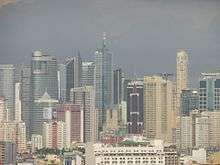 |
Makati | 171 hectares (420 acres) |
| Ortigas Center |  |
Shared between Pasig, Mandaluyong and Quezon City | 100 hectares (250 acres) |
| Bonifacio Global City | 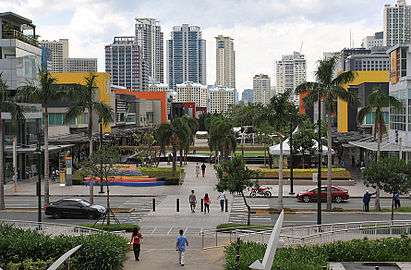 |
Taguig | 240 hectares (590 acres) |
| Binondo | 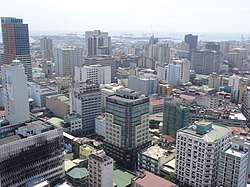 |
City of Manila | 66 hectares (160 acres) |
| Filinvest City | Muntinlupa | 806 hectares (1,990 acres) |
| Name | Image | City/municipality | Area | Developer | Cost | Ref |
|---|---|---|---|---|---|---|
| Araneta City | .jpg) |
Quezon City | 35 hectares (86 acres) |
The Araneta Group | ₱80 Billion (Redevelopment) | |
| Arca South |  |
Taguig | 74 hectares (180 acres) |
Ayala Land | ₱80 billion | |
| Aseana City | (2018-08-25).jpg) |
Parañaque | 204 hectares (500 acres) |
Aseana Holdings Inc. | ||
| Ayala Center |  |
Makati | 50 hectares (120 acres) |
Ayala Land | ||
| Bay City Reclamation Project (Boulevard 2000) | Shared between Pasay and Parañaque | 200 hectares + 210 hectares + 73 hectares + 173 hectares[71] 626 hectares (1,550 acres) |
Philippine Reclamation Authority | |||
| Capitol Commons | 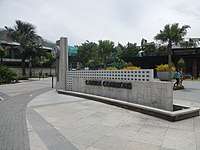 |
Pasig | 10 hectares (25 acres) |
Ortigas & Company | ₱25–60 billion | |
| Century City | 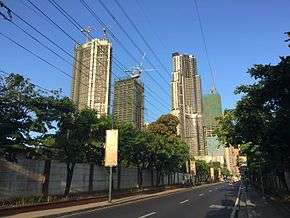 |
Makati | 3.4 hectares (8.4 acres) |
Century Properties | ||
| Circuit Makati | 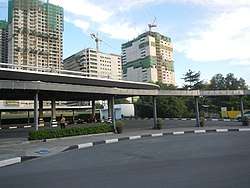 |
Makati | 21 hectares (52 acres) |
Ayala Land | ||
| The Cloverleaf | Quezon City | 11 hectares (27 acres) |
Ayala Land | |||
| Eastwood City |  |
Quezon City | 18.5 hectares (46 acres) |
Megaworld Corporation | ||
| Entertainment City | 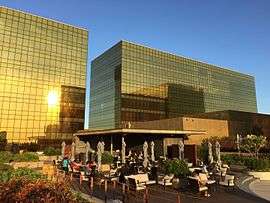 |
Parañaque | 40 hectares (99 acres) |
PAGCOR | ||
| Eton Centris | 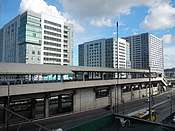 |
Quezon City | 12 hectares (30 acres) |
Eton Properties | ||
| Greenfield District | Mandaluyong | 15 hectares (37 acres) |
Greenfield Development Corporation | |||
| Madrigal Business Park | Muntinlupa | 10 hectares (25 acres) |
Ayala Land | |||
| McKinley Hill | Taguig | 50 hectares (120 acres) |
Megaworld Corporation | |||
| Newport City | Pasay | 25 hectares (62 acres) |
Megaworld Corporation | |||
| Neopolitan Business Park | Quezon City | 22.29 hectares (55.1 acres) |
Asia Pacific Group of Companies | |||
| Riverbanks Center | Marikina | 23 hectares (57 acres) |
Riverbanks Development Corporation | |||
| Robinsons Cybergate | Mandaluyong | 6 hectares (15 acres) |
Robinsons Land Corporation | |||
| Rockwell Center |  |
Makati | 15.5 hectares (38 acres) |
Rockwell Land | ||
| San Lazaro Tourism and Business Park | 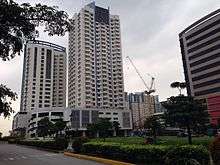 |
City of Manila | 16 hectares (40 acres) |
Manila Jockey Club Investments Corp. | ||
| Triangle Park (Quezon City Central Business District) |
_(Diliman%2C_Quezon_City)(2017-09-07)_cropped.jpg) |
Quezon City | 250 hectares (620 acres) | Quezon City Government | ||
| U.P.-Ayala Land TechnoHub | Quezon City | 38 hectares (94 acres) |
Ayala Land | ₱6 billion |
| Name | City/municipality | Area | Developer | Cost | Status |
|---|---|---|---|---|---|
| Arcovia City | Pasig | 12.3 hectares (30 acres) |
Megaworld Corporation | ₱35 Billion | Pre-construction |
| Bridgetown | Shared between Pasig and Quezon City | 12 hectares (30 acres) |
Robinsons Land Corp. | ₱30 Billion | Under Construction |
| Circulo Verde | Pasig | 10-12 hectares (30 acres) |
Ortigas & Company | ₱30 Billion | Under Construction |
| McKinley West | Taguig | 34.5 hectares (85 acres) |
Megaworld Corporation | P45 billion | Under Construction |
| New Manila Bay–City of Pearl | City of Manila | 407.43 hectares (1,006.8 acres) |
UAA Kinming | Planning stage | |
| Ninoy Aquino Business Park | Las Piñas | 15.922.5 hectares (56 acres) |
Anchor Land Holdings | ₱45 Billion | Pre-construction |
| Northwoods City | Caloocan City | 7.510.8 hectares (27 acres) |
Vista Land Inc. | ₱25 Billion | Pre-construction |
| Ortigas East | Pasig | 16 hectares (40 acres) |
Ortigas & Company | ₱50 Billion | Pre-construction |
| Parklinks | Quezon City | 35 hectares (86 acres) |
Ayala Land and Eton Properties | ₱53 Billion | Under Construction |
| South Park District | Muntinlupa | 6.6 hectares (16 acres) |
Ayala Land | ₱12 Billion | Under construction |
| Vertis North | Quezon City | 29 hectares (72 acres) |
Ayala Land | ₱65 Billion | Under construction |
| Vista City | Shared Between Las Piñas, Muntinlupa, Bacoor and San Pedro, Laguna | 1,500 hectares (3,700 acres) |
Vista Land | ₱50 Billion | Pre-construction |
| Westside City | Entertainment City, Parañaque | 31 hectares (77 acres) |
Megaworld Corporation | ₱121 Billion | Under construction |
Shopping

Global Blue ranked Manila as one of the "Best Shopping Destinations" in Asia.[72][73] Metro Manila is home to some of the largest shopping malls in the world, three of which are in the top 10. SM Megamall in Mandaluyong ranks as the 3rd largest shopping mall in the world, followed by SM City North EDSA in Quezon City bagging the 4th place. Meanwhile, SM Mall of Asia in Pasay ranks as the 9th largest shopping mall in world. Other shopping malls in Metro Manila in the list of the largest shopping malls in Metro Manila are the Ever Gotesco Commonwealth Center, Festival Supermall, Greenbelt, Market! Market!, SM Aura Premier, SM Southmall and TriNoma.
Tourism and Gambling
Tourism is a vital industry of the region. Metro Manila is the main gateway to the Philippines. Trade and tourism represents 31.4% of share of NCR's output by industry according to Brookings Institution.[58] Metro Manila welcomed 974,379 overnight visitors in 2012, making it the top overnight tourist destination of the country.[74] Manila is visited by the majority of international tourists coming to the country registering a total of 3,139,756 arrivals in 2012.[75]
Metro Manila has opened 4,612 hotel rooms in 2015. It is also expected to exceed the 3,500 annual addition of hotel rooms in the next two years.[76][77][78] Gambling in Metro Manila has also become a popular tourist attraction in the region. Metro Manila is a popular gaming destination in Asia,[79] rivaling other major gaming destinations such as Macau and Singapore.[80][81] There are around 20 casinos in the metropolis,[82] featuring luxurious casino hotels and integrated resorts. Its thriving local gambling market makes Manila attractive to casino operators.[83] Popular gaming destinations are Resorts World Manila in Newport City in Pasay, Solaire Resort & Casino, City of Dreams Manila, Okada Manila, Westside City Resorts World, and NayonLanding in Entertainment City in Bay City, Parañaque.[84]

Intramuros is the historic walled area within the modern City of Manila. Originally, it was considered to be Manila itself at the time when the Philippines was under the Spanish Empire colonial rule. Owing to its history and cultural value, Intramuros and Rizal Park were designated as flagship destination to become a tourism enterprise zone in the Tourism Act of 2009.[33] Intramuros is managed by the Intramuros Administration.
The architecture of Intramuros reflects the Spanish colonial style and the American neoclassical architectural style, since the Philippines was a colony of Spain and the United States before it was granted its independence in 1946. Kalesa is a popular mode of transportation in Intramuros and nearby places[85] such as Binondo, Ermita and the Rizal Park.
Popular tourist destinations in Intramuros include the Baluarte de San Diego, Club Intramuros Golf Course, Cuartel de Santa Lucia, Fort Santiago, Manila Cathedral, Palacio Arzobispal, Palacio de Santa Potenciana, Palacio del Gobernador, Plaza Mexico, Plaza de Roma, San Agustin Church and its newest tourist attraction, the Ayuntamiento de Manila.[86]
Some of the country's oldest schools are founded in Intramuros, these are the University of Santo Tomas (1611), Colegio de San Juan de Letran (1620), and Ateneo de Manila University (1859). Only Colegio de San Juan de Letran (1620) remains at Intramuros; the University of Santo Tomas transferred to a new campus at Sampaloc in 1927, and Ateneo left Intramuros for Loyola Heights, Quezon City (while still retaining "de Manila" in its name) in 1952. Other prominent educational institutions include the Manila High School and the University of the City of Manila.
Culture and contemporary life
Metro Manila is widely celebrated in popular lore, frequently the setting for mostly Filipino books, movies, and television programs. Flores de Mayo is widely celebrated throughout all the places in Metro Manila. The yearly Metro Manila Film Festival, inaugurated in 1966, is the forerunner of all Philippine film festivals.
Arts


Metro Manila is the home to the National Museum of the Philippines, the national museum of the country. It operates a chain of museums located in the grounds of Rizal Park just outside Intramuros, such as the National Museum of Fine Arts, the National Museum of Anthropology and the National Museum of Natural History. The National Museum complex occupies the place and buildings that were a part of a new capital center proposed by Daniel Burnham in 1901.
Prominent museums in Metro Manila include the Ayala Museum, Bahay Tsinoy, Casa Manila, Lopez Museum, Metropolitan Museum of Manila, The Mind Museum, Museo Pambata, Museo Valenzuela, Museum of Philippine Political History, Pasig City Museum and the Rizal Shrine. Museums established by educational institutions are the Ateneo Art Gallery, Jorge B. Vargas Museum and Filipiniana Research Center, Museum of Contemporary Art and Design,[87] UP Museum of a History of Ideas, and the UST Museum of Arts and Sciences.
The national theater of the Philippines, known as the "Tanghalang Pambansa", is situated on a 62 hectares (150 acres) cultural center called the Cultural Center of the Philippines Complex. The complex is located between the cities of Manila and Pasay. Aside from the CCP, other popular performing arts venue include Cuneta Astrodome, Mall of Asia Arena, Rizal Park, Quezon Memorial Circle and Smart Araneta Coliseum. Other venues used are the UPFI Film Center and UP Theater in the University of the Philippines Diliman. The famed Manila Metropolitan Theater, also known as The Met, was constructed in 1931 and was known as the "Grand Dame" among all the Art Deco theaters of Manila. Years of neglect forces its closure in 1996. The Met will be restored through a tripartite agreement with the National Commission for Culture and the Arts, the National Museum of the Philippines and the Escuela Taller.
Religion
Roman Catholicism is the predominant religion in Metro Manila.[88] Other Christian denominations, Muslims, Anitists, animists, and atheists are the minority. Among the most important religious sites in the region are Manila Cathedral, San Sebastian Church (Manila), Tondo Church, San Agustin Church (Manila), Quiapo Church and Baclaran Church.
Sports
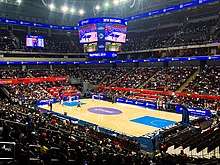
The National Capital Region is the home to the headquarters of the ASEAN Basketball League, Baseball Philippines, Philippine Basketball Association, Maharlika Pilipinas Basketball League, Philippine Super Liga, Shakey's V-League and the Philippines Football League. Collegiate leagues based in the National Capital Region are the Colleges and Universities Sports Association, National Athletic Association of Schools, Colleges and Universities, National Collegiate Athletic Association, National Capital Region Athletic Association, State Colleges and Universities Athletic Association, Universities and Colleges Athletic Association, University Athletic Association of the Philippines, Women's National Collegiate Athletic Association, Men's National Collegiate Athletic Association and University of Makati's Association of Local Colleges and Universities.
Two national sports complex is located in the region, the Rizal Memorial Sports Complex and the PhilSports Complex. The Wack Wack Golf and Country Club has hosted major tournaments such as the Philippine Open and the World Cup. Prominent sporting venues in Metro Manila include the Smart Araneta Coliseum, Mall of Asia Arena, Filoil Flying V Arena and the Cuneta Astrodome. The Greater Manila Area is also home to the Philippine Arena, the world's largest indoor arena.[89] It is located in Bocaue, Bulacan and it has a maximum capacity of 55,000 people.[90]
Metro Manila's, and in general the country's main sport is basketball. Another popular sport in the city are cue sports, and billiard halls are found in many places. Baseball, volleyball, football and swimming are also widely played sports. The region has been the champion of the Palarong Pambansa for 13 straight years.[91] Manila Storm are a rugby league team training out of Rizal Park (Luneta Park) and playing home matches at the Southern Plains Field, Calamba, Laguna. The Metro Manila area is also home to a number of rugby union teams such as the Alabang Eagles, Makati Mavericks, Manila Nomads Sports Club and the Manila Hapons.
Human resources
Education

Since the Spanish colonial period, Manila has been the center of education. The University of Santo Tomas (1611), Colegio de San Juan de Letran (1620) and Ateneo de Manila University (1859) are some of the oldest educational institutions that was established during the colonial period. The University of the Philippines, along with seven other State Universities and Colleges (SUC), namely the Eulogio "Amang" Rodriguez Institute of Science and Technology, Marikina Polytechnic College, Philippine Normal University, Philippine State College of Aeronautics, Polytechnic University of the Philippines, Rizal Technological University and the Technological University of the Philippines, are based in Metro Manila. Manila's University Belt form the largest concentration of higher education institutes in the Philippines, making Manila the center for higher learning in the country. The country's top ranked universities, located in Metro Manila, are widely known to be as follows, University of the Philippines, Ateneo de Manila University, De La Salle University, and University of Santo Tomas.[92][93]
Prominent secondary schools in Metro Manila include the Philippine Science High School in Diliman, Quezon City, the national science school of the Philippines and the Manila Science High School in Ermita, the forerunner of all the science schools in the country. Primary and secondary education is in the region is governed by the Department of Education-National Capital Region (DepEd-NCR). Meanwhile, the higher educational institutions are under the CHED-National Capital Region.
The region has the highest literacy rate among all the regions of the Philippines, with 99.2% in 2008. Literacy rate for males is at 99.0% while literacy rate for females is at 99.4%.[94] For the school year of 2008–2009, Metro Manila has 511 public elementary schools and 220 public secondary schools. There are 309 tertiary (public and private) institutions as of the year-end of 2009. For the said school year, enrollment in public elementary schools is at 1,219,333, public secondary schools at 661,019 and 687,096 for tertiary (public and private) institutions.[57]
Public health
Healthcare in Metro Manila is mostly provided by private corporations. 72% of region's hospitals are privately owned. As of 2009, the region has 179 hospitals. Quezon City has the most number of hospitals while Valenzuela and Pateros do not have any.[95] In 2008, government health workers in NCR comprises 590 doctors, 498 dentists, 4,576 nurses, and 17,437 midwives. Furthermore, Metro Manila has 27,779 beds with a ratio of 2.47 per 1,000 population as of 2008.[96] The region has the lowest malnutrition rate among all the regions in the country.[97]
The headquarters of the World Health Organization Regional Office for the Western Pacific, and the World Health Organization Country Office for the Philippines are in region. The main office of the Department of Health, the national health department, is also in the region.
Metro Manila is designated by the Department of Health as the pioneer of medical tourism, expecting it to generate $1 billion in revenue annually.[98] However, lack of progressive health system, inadequate infrastructure and the unstable political environment are seen as hindrances for its growth.[99] Under the Philippine Medical Tourism Program, there are 16 participating hospitals (private and public) in Metro Manila with a total number of 6,748 beds as of 2013.[100] Five out of six hospitals in the country accredited by the Joint Commission International are in the region, these are the Asian Hospital and Medical Center, Makati Medical Center, St. Luke's Medical Center – Global City, St. Luke's Medical Center – Quezon City and The Medical City.[101]
East Avenue in Quezon City is the location of prominent national health centers: the Lung Center of the Philippines, National Kidney and Transplant Institute, and the Philippine Heart Center. Other national special hospital in Metro Manila include the Philippine Orthopedic Center in Quezon City, and the National Center for Mental Health in Mandaluyong. The Philippine General Hospital, the country's premier state-owned tertiary hospital is located at the City of Manila. The St. Luke's Medical Center which operates in Quezon City and Taguig, is a private tertiary referral hospital cited as one of the best hospitals in the world.[102][103]
Public safety
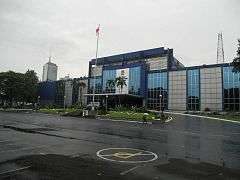
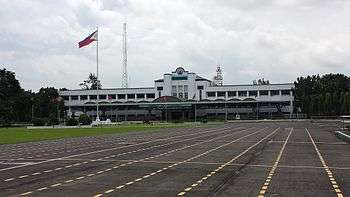
The Philippine National Police is responsible for law enforcement in the country. Its headquarters is located at Camp Crame along Bonny Serrano Avenue, Quezon City. The National Capital Region Police Office (NCRPO) is the regional branch of PNP that operates in the region. Its headquarters is located at Camp Bagong Diwa in Bicutan, Taguig. Under the supervision of NCRPO, Metro Manila is divided into five police districts. The five police districts are the Northern Police District, Eastern Police District, Southern Police District and Quezon City Police District.[104]
Metro Manila has the highest rate of crime in the country in 2014, with 59,448 crimes reported (excluding crimes reported in barangay level) with 25,353 of these crimes committed against persons.[105] Following criticisms of high crime rate in Metro Manila, the Philippine National Police launched a relentless anti-crime drive that resulted in the decrease of crimes in the metropolis.[106][107] As of March 2015 Metro Manila's crime rate is down by 50%. From an average of 919 crimes reported weekly, it has gone down to 412. Recorded robberies and theft also decreased by 63 in just a month.[108] All the 159 police community precincts of Metro Manila will be using the electronic blotter system in recording crimes starting June 2015.[109]
The Bureau of Fire Protection National Capital Region provides fire protection and technical rescue as well as emergency medical services to the metropolis. It is broadly organized into five firefighting districts: Manila, Quezon City, District II, District III and District IV.
The headquarters of the Armed Forces of the Philippines is located at Camp Aguinaldo, along with the Department of National Defense, in Murphy, Quezon City. Aside from Camp Aguinaldo, other military bases situated in the region are Camp Atienza and Fort Bonifacio. The Philippine Army has their headquarters at Fort Bonifacio, Taguig. The Villamor Air Base in Ninoy Aquino International Airport is the home to the headquarters of the Philippine Air Force while the headquarters of the Philippine Navy is located at Roxas Boulevard, Malate, Manila.
The Philippine Coast Guard is headquartered at Port Area (Manila South Harbor), City of Manila. Its Coast Guard NCR District also has its headquarters in the city and has another Coast Guard Station in Pasig. It also has a base in Taguig and maintains several detachments located in Navotas, Parañaque, Tangos, Vitas, Manila North Harbor, Manila South Harbor and the Cultural Center of the Philippines.[110]
In 2012, the AFP Joint Task Force-National Capital Region was launched to ensure peace and stability in Metro Manila, bearing the same function of the deactivated National Capital Regional Command, although it operates on a much smaller size than its predecessor.[111]
Infrastructure
Transportation
According to the Land Transportation Franchising and Regulatory Board, public ridership in Metro Manila composes of the following: 46% of the people go around by jeepneys, 32% by private vehicle, 14% by bus, and 8% use the railway system.[112] Transportation development in Metro Manila follows the Metro Manila Dream Plan, which consists of building short-term to long-term infrastructure lasting up to 2030 and addressing its issues on traffic, land use and environment.[113][114]
Roads and highways
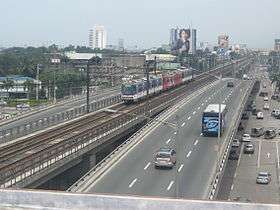
The roads of Metro Manila is built around the City of Manila. Roads are classified as local, national or subdivision roads. There are ten radial roads branching out from the city. Also there are five circumferential roads forming a series of concentric semi-circular arcs around Manila. The circumferential and radial roads are systems of interconnected roads, bridges and highways. A problem with the circumferential roads are the missing road links. These are the roads that are not yet constructed to give way for development due to Metro Manila's rapid urbanization. The metropolis is resolving this problem through the completion of missing road links or through the construction of connector roads.
An important circumferential road is the Circumferential Road 4, the Epifanio de los Santos Avenue or more popularly known as EDSA. It traverses the cities of Pasay, Makati, Mandaluyong, Quezon City and Caloocan. Line 3 follows the alignment of EDSA, from Taft Avenue in Pasay up to TriNoma, terminating before it reaches Caloocan. Circumferential Road 5 serves the people near the regional limits of Metro Manila and also serves as an alternate route for Circumferential Road 4.
Prominent radial road include the Radial Road 1, composed of Roxas Boulevard and the Manila-Cavite Expressway (Coastal Road) that connects Metro Manila to Cavite, Radial Road 3 or the South Luzon Expressway that connects Metro Manila to Laguna, Radial Road 6, composed of Aurora Boulevard and Marcos Highway that runs up to Rizal and Radial Road 8 or the North Luzon Expressway that serves as the gateway to the north.
The radial and circumferential road system are being supplanted by a new numbered highway system implemented by the Department of Public Works and Highways, and new signage are being placed with its implementation. Expressways are being assigned numbers with the E prefix. National roads are assigned 1 to 3 digit numbers, except for those classified as tertiary national roads.
The development of roads, highways and expressways are based on the Metro Manila Dream Plan. Ongoing projects in the dream plan include the rehabilitation of EDSA, Skyway Stage 3 and the construction of the missing road links for the circumferential roads (e.g. Taft Avenue Flyover, Metro Manila Interchange Project Phase IV).

Railway systems
Metro Manila has three rapid transit lines. The Manila Light Rail Transit System (LRTA) operates the Line 1 (Green Line) and the Line 2 (Blue Line). On the other hand, the Manila Metro Rail Transit System operates the Line 3 (Yellow Line) which traverses EDSA. The Philippine National Railways operates a commuter rail service in Metro Manila called the PNR Metro South Commuter. Its main terminal, Tutuban, is located in Tondo. The most troublesome metro line is Line 3 which has been plagued with frequent and severe disruptions. Line 1 has an average weekday ridership of 560,000,[115] while Line 2 has an average weekday ridership of 200,000. While in Line 3 serves roughly 650,000 on an average weekday. In February 2014, a total of 14.06 million passengers took Line 1 while 6.13 million took Line 2.[116]
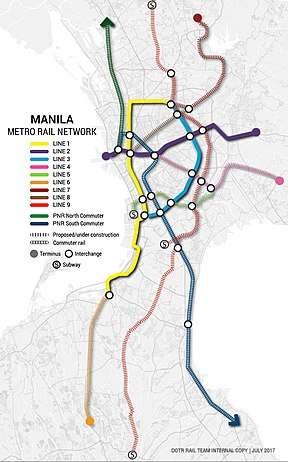
To improve rail transport within the region, several railway projects are being undertaken by the national government:
- The North–South Commuter Railway's first phase is under construction, while the other two phases are already approved. When completed in 2023, it will connect Central Luzon and Calabarzon to Metro Manila by rail. It will also supersede the current PNR Metro Commuter Line.
- Line 9 (Metro Manila Subway) began construction in 2019. When completed, it will be the third heavy rail line in the country after Line 2 and Line 7. Partial operations are to begin by 2022, and full operations is slated for 2025.
- Line 7 (Red Line) is under construction. When completed, it will connect Metro Manila to the province of Bulacan.
- A Common Station, connecting Line 1, Line 3, Line 7, and Line 9 is planned, although bureaucracy in the Department of Transportation, corporate feud and issues related to its proposed location are hindrances of its construction.[117][118][119][120]
- Line 1 will be extended up to Bacoor in the province of Cavite.[115] Construction started in 2019.
- Line 2 will be extended to Rizal with the East Extension project and to the Port of Manila with the West Extension Project. The East Extension Project is on-going while the proposed West Extension Project is in the planning stage.[121][122]
- Line 3 will be undergoing rehabilitation after years of poor maintenance from the previous administration.
Air
Ninoy Aquino International Airport (NAIA) is the only airport and the premier gateway in Metro Manila. It is the busiest airport in the Philippines.[123] NAIA has four terminals: Terminal 1, Terminal 2 (which is exclusively used by the Philippine Airlines), Terminal 3 (the newest and largest airport terminal in NAIA) and Terminal 4 (also known as the Manila Domestic Passenger Terminal). The other airport that serves Metro Manila is the Clark International Airport in Angeles which is located 80 kilometers (50 mi) away.
Buses
Bus franchises in the region are regulated by the Land Transportation Franchising and Regulatory Board. The Premium Point-to-Point Bus Service is the express bus system that runs from its dispatch terminal in Fairview up to the central business districts along EDSA. It aims to cut travel time substantially and provide a faster, safer and more convenient bus service to commuters, who are usually caught at the heavy traffic across the metropolis.[124][125] A second express bus link from SM North EDSA, Trinoma and SM Megamall to Makati opened in December 2015, and by January 2016 was the line on which, for the first time in nearly three decades, a double-decker bus traveled on EDSA, to the delight of motorists, followed by a third link, this time from Robinsons Galleria to the Ayala Center complex in February 2016 and a fourth in March linking the Ayala Center to the Alabang Town Center in Muntinlupa via the Metro Manila Skyway (and later to Ayala Malls South Park). As of the present express buses also link the Market Market mall and Circuit Makati to both the Nuvali residential township and the Pacita Village complex in San Pedro, both in Laguna, in services launched in 2014 and 2017, respectively (plus additional services to the UP Town Mall in Quezon City and SM Masinag in Antipolo, Rizal), while intercity express buses have been in operation since 2015 to alleviate traffic on EDSA. In 2018, additional services from the Makati CBD and from San Lorenzo Place up to Cavite debuted.
Metro Manila will have its bus rapid transit system operational by 2018. The 27.7 kilometers (17.2 mi) proposed BRT system will traverse Commonwealth Avenue up to the Manila City Hall. The planned BRT system costs ₱4.9 billion ($109.5 million) and will have a fleet of 300 buses and 32 stations.[126][127]
Ferry
The Pasig River Ferry Service run by the Metropolitan Manila Development Authority is the principal ferry shuttle system of Metro Manila. It traverses the Pasig River from Barangay Pinagbuhatan in Pasig to Plaza Mexico in Intramuros. Although it was referred to as a ferry, it is more akin to a water bus. It has 17 stations, but only 14 are operational. Another ferry route called the Manila-Bataan Ferry was launched on May 10, 2017 and traverses Manila Bay from the Bay Terminal at CCP Complex in Manila to Orion, Bataan. A new ferry route known as the Cavite-Manila Ferry Service that runs between Noveleta, Cavite and Intramuros was launched in January 2018.
Electricity and water
Meralco is the sole electric distributor of Metro Manila. It generates its power from the National Power Corporation and other independent power producers in Luzon. The Metropolitan Waterworks and Sewerage System (MWSS) was responsible for the supply and delivery of potable water and the sewerage system in Metro Manila. It was privatized in 1997 and the region and its immediate surrounding areas was split into the east and west concession. The winning corporations provides the same function of MWSS.
The Maynilad Water Services took over the west zone, which is composed of Manila (excluding the southeastern part of the city), Caloocan, Las Piñas, Malabon, Muntinlupa, Navotas, Parañaque, Pasay and Valenzuela. It also operates in some parts of Makati and Quezon City. Manila Water operates on the east zone, comprising the cities of Mandaluyong, Marikina, Pasig, Pateros, San Juan and Taguig. It also operates in large areas of Makati and Quezon City and the southeastern part of Manila, which was excluded from the west zone.
For garbage hauling, the region spent ₱4.221 billion ($93.855 million) in 2013. Quezon City spent the most at ₱994.59 million ($22.115 million) while Pateros, the region's only municipality, spent the least amount of money on garbage at ₱9.478 million ($210,747).[128]
See also
References
- "Presidential Decree No. 824 November 7, 1975". lawphil.net. Arellano Law Foundation. Archived from the original on March 12, 2016. Retrieved January 14, 2014.
- Manasan, Rosario; Mercado, Ruben (February 1999). "Governance and Urban Development: Case Study of Metro Manila" (PDF). Philippine Institute for Development Studies Discussion Paper Series (99–03). Archived (PDF) from the original on December 16, 2018. Retrieved December 15, 2018.
- Census of Population (2015). "National Capital Region (NCR)". Total Population by Province, City, Municipality and Barangay. PSA. Retrieved June 20, 2016.
- "The Principal Agglomerations of the World". citypopulation.de. Archived from the original on September 13, 2018. Retrieved December 8, 2017.
- Economy of the Philippines#Regional Accounts
- "Presidential Decree No. 824". chanrobles.com. Chan Robles Virtual Law Library. Archived from the original on October 6, 2017. Retrieved January 14, 2014.
- "No, Mareng Winnie, Metro Manila is not the 'paborito'; it is the 'tagasalo'". Interaksyon. January 19, 2015. Archived from the original on March 8, 2015. Retrieved March 5, 2015.
- "Presidential Decree No. 824 November 7, 1975. Creating the Metropolitan Manila and the Metropolitan Manila Commission and for Other Purposes". Arellano Law Foundation. November 7, 1975. Archived from the original on March 12, 2016. Retrieved March 27, 2015.
- "Presidential Decree No. 940 June 24, 1976". Chan C. Robles Virtual Law Library. Archived from the original on March 7, 2016. Retrieved April 22, 2013.
- "Presidential Decree No. 1396, s. 1978". Official Gazette of the Republic of the Philippines. Retrieved September 22, 2015.
- Kumar, Ravindra (2004). Mahatma Gandhi At The Close Of Twentieth Century. Anmol Publications Pvt. Ltd. p. 168. ISBN 978-81-261-1736-9.
- "Was Marcos right? Do we need a governor for Metro Manila?". InterAksyon. Archived from the original on April 2, 2015. Retrieved March 27, 2015.
- "San Pedro City eyed as 18th member of MMDA". Manila Bulletin. December 30, 2014. Archived from the original on December 31, 2014. Retrieved March 8, 2015.
- "Press Release – Koko seeks the creation of San Pedro City as a separate congressional district". www.senate.gov.ph. Senate of the Philippines. January 4, 2016. Archived from the original on September 7, 2018. Retrieved September 8, 2018.
- "Senate Bill No. 3029". Archived from the original on September 8, 2018. Retrieved September 17, 2018.
- Luna, Franco. "Travel to and from Manila suspended from March 15 as Code Red Sublevel 2 raised over COVID-19". philstar.com. Archived from the original on March 12, 2020. Retrieved March 12, 2020.
- "Governance and Development: Case Study of Metro Manila" (PDF). Philippine Institute for Developmental Studies. February 1999. Archived from the original (PDF) on March 13, 2016. Retrieved March 8, 2015.
- Lila Ramos Shahani (May 11, 2015). "Living on a Fault Line: Manila in a 7.2 Earthquake". The Philippine Star. Archived from the original on May 18, 2015. Retrieved May 11, 2015.
- Lozada, Bong (March 27, 2014). "Metro Manila is world's second riskiest capital to live in–poll". Philippine Daily Inquirer. Archived from the original on March 7, 2016. Retrieved April 9, 2014.
- "Temperatures drop further in Baguio, MM". Philippine Star. Archived from the original on October 25, 2014. Retrieved October 12, 2014.
- "Metro Manila temperature soars to 36.2C". ABS-CBN News. Archived from the original on December 26, 2014. Retrieved October 12, 2014.
- "Manila". Jeepneyguide. Archived from the original on August 22, 2016. Retrieved March 4, 2014.
- "Port Area Manila Climatological Normal Values". Philippine Atmospheric, Geophysical and Astronomical Services Administration. Archived from the original on September 19, 2018. Retrieved September 19, 2018.
- "Port Area Manila Climatological Extremes". Philippine Atmospheric, Geophysical and Astronomical Services Administration. Archived from the original on September 19, 2018. Retrieved September 19, 2018.
- Cappelen, John; Jensen, Jens. "Filippinerne – Manila, Luzon" (PDF). Climate Data for Selected Stations (1931–1960) (in Danish). Danish Meteorological Institute. Archived from the original (PDF) on April 27, 2013. Retrieved September 19, 2018.
- "NAIA Pasay City Climatological Normal Values". Philippine Atmospheric, Geophysical and Astronomical Services Administration. Archived from the original on October 10, 2018. Retrieved October 10, 2018.
- "NAIA Pasay City Climatological Extremes". Philippine Atmospheric, Geophysical and Astronomical Services Administration. Archived from the original on October 10, 2018. Retrieved October 10, 2018.
- "Science Garden Quezon City Climatological Normal Values". Philippine Atmospheric, Geophysical and Astronomical Services Administration. Archived from the original on September 23, 2018. Retrieved September 23, 2018.
- "Science Garden Quezon City Climatological Extremes". Philippine Atmospheric, Geophysical and Astronomical Services Administration. Archived from the original on September 23, 2018. Retrieved September 23, 2018.
- "Annual Audit Report of the National Parks and Development Committee" (PDF). National Parks and Development Committee. December 31, 2011. Archived from the original (PDF) on April 2, 2015. Retrieved March 12, 2015.
- "Protected Areas in National Capital Region". Biodiversity Management Bureau. Archived from the original on April 2, 2015. Retrieved May 11, 2015.
- Gwen de la Cruz (January 12, 2015). "FAST FACTS: Rizal Park". Rappler. Archived from the original on March 7, 2016. Retrieved March 8, 2015.
- "REPUBLIC ACT No. 9593 otherwise known as Tourism Act of 2009 and Its Implementing Rules and Regulations" (PDF). Department of Tourism. Archived from the original (PDF) on April 30, 2015. Retrieved March 8, 2015.
- "Paco Park". Archived from the original on December 19, 2013. Retrieved May 3, 2014.
- Jenny F. Manongdo (May 21, 2015). "Manila Zoo renovation underway by July". Manila Bulletin. Archived from the original on May 22, 2015. Retrieved May 22, 2014.
- "Information Sheet on Ramsar Wetlands (RIS) – 2009–2014" (PDF). Wetlands International. Archived from the original (PDF) on July 14, 2014. Retrieved July 4, 2014.
- "The Annotated Ramsar List: Philippines". Ramsar Convention. Archived from the original on October 8, 2013. Retrieved July 4, 2014.
- "Metro Manila's 'secret' wildlife sanctuary – and why it might disappear soon". GMA News Online. March 11, 2015. Archived from the original on April 2, 2015. Retrieved March 11, 2015.
- "Bill creating new Metro Manila body backed". Philippine Star. Archived from the original on October 6, 2014. Retrieved September 30, 2014.
- "DOJ backs creation of Metropolitan Manila Regional Administration". Inquirer.net. Archived from the original on April 2, 2015. Retrieved March 8, 2015.
- "An Update on the Earthquake Hazards and Risk Assessment of Greater Metropolitan Manila Area" (PDF). Philippine Institute of Volcanology and Seismology. November 14, 2013. Archived from the original (PDF) on June 24, 2016. Retrieved May 16, 2016.
- "Enhancing Risk Analysis Capacities for Flood, Tropical Cyclone Severe Wind and Earthquake for the Greater Metro Manila Area Component 5 – Earthquake Risk Analysis" (PDF). Philippine Institute of Volcanology and Seismology and Geoscience Australia. Archived (PDF) from the original on August 6, 2016. Retrieved May 16, 2016.
- "Land Use Classification". Municipality of Pateros. Archived from the original on September 15, 2008. Retrieved April 7, 2016.
- "Municipal and City Level Estimates" (PDF). National Statistical Coordination Board. Archived from the original (PDF) on November 13, 2013. Retrieved July 14, 2014.
- "Environmental Management Bureau – National Capital Region". Environmental Management Bureau. Archived from the original on July 25, 2014. Retrieved July 17, 2014.
- "An Update on the Earthquake Hazards and Risk Assessment of Greater Metropolitan Manila Area" (PDF). Philippine Institute of Volcanology and Seismology. November 14, 2013. Retrieved May 16, 2016.
- "Enhancing Risk Analysis Capacities for Flood, Tropical Cyclone Severe Wind and Earthquake for the Greater Metro Manila Area Component 5 – Earthquake Risk Analysis" (PDF). Philippine Institute of Volcanology and Seismology and Geoscience Australia. Retrieved May 16, 2016.
- Pateros; Land Use Classification
- "Archived copy". Archived from the original on December 31, 2014. Retrieved July 28, 2015.CS1 maint: archived copy as title (link)
- "Archived copy". Archived from the original on December 31, 2014. Retrieved March 8, 2015.CS1 maint: archived copy as title (link)
- "San Pedro City eyed as 18th member of MMDA | Manila Bulletin | Latest Breaking News | News Philippines". December 31, 2014. Archived from the original on December 31, 2014. Retrieved September 8, 2018.
- "2010 Census of Population and Housing: National Capital Region" (PDF). Philippine Statistics Authority of the Republic of the Philippines. Archived from the original (PDF) on June 25, 2012. Retrieved April 6, 2012.
- "National Capital Region. Total Population by Province, City, Municipality and Barangay: as of May 1, 2010" (PDF). Philippine Statistics Authority of the Philippines. Archived from the original (PDF) on November 15, 2012. Retrieved December 22, 2012.
- Paul Roy (September 18, 2014). "In the slums of Manila, inequality is so bad that the worst off have no chance to protest". The New Statesman. Archived from the original on June 16, 2016. Retrieved November 4, 2016.
- "Archived copy". Archived from the original on June 13, 2019. Retrieved November 21, 2019.CS1 maint: archived copy as title (link)
- "Per Capita GRDP". National Statistical Coordination Board. July 25, 2013. Archived from the original on April 2, 2015. Retrieved March 5, 2015.
- "Statwatch – National Capital Region". National Statistical Coordination Board. December 10, 2012. Archived from the original on March 17, 2015. Retrieved March 5, 2015.
- "2014 Global Metro Monitor Map". Brookings Institution. Archived from the original on March 21, 2015. Retrieved March 6, 2015.
- "Global firms fuel record surge in Manila office space". GMA News Online. February 26, 2015. Archived from the original on April 2, 2015. Retrieved March 5, 2015.
- "PH real estate sector to stay strong in 2015". INQUIRER.net. February 25, 2015. Archived from the original on February 27, 2015. Retrieved March 5, 2015.
- "Our country's hope". INQUIRER.net. August 24, 2014. Archived from the original on March 15, 2015. Retrieved March 21, 2015.
- "PH real estate gets boost from BPOs, hospitality, gaming, retail". Manila Standard Today. March 6, 2015. Archived from the original on May 23, 2015. Retrieved March 20, 2015.
- Doris Dumlao-Abadilla (May 22, 2015). "Metro Manila makes it to top 30 megacities list". INQUIRER.net. Archived from the original on April 2, 2015. Retrieved May 22, 2015.
- "PH real estate gets boost from BPOs, hospitality, gaming, retail". Manila Standard Today. March 6, 2015. Archived from the original on March 18, 2015. Retrieved March 20, 2015.
- "DOLE approves P15 wage hike in Metro Manila". INQUIRER.net. March 18, 2015. Archived from the original on March 28, 2015. Retrieved March 19, 2015.
- "Metro Manila minimum wage now at P481". Manila Times. March 18, 2015. Archived from the original on April 2, 2015. Retrieved March 19, 2015.
- "Good news but… Metro Manila minimum pay up by P15". INQUIRER.net. March 19, 2015. Archived from the original on March 19, 2015. Retrieved March 20, 2015.
- "P25 wage hike takes effect on November 22, 2018". philstar.com. Archived from the original on November 12, 2018. Retrieved November 15, 2018.
- "Working in the Philippines". Make it Makati. Archived from the original on April 27, 2013. Retrieved March 5, 2015.
- Roderick T. dela Cruz (January 3, 2015). "Fort Bonifacio eclipsing Makati CBD". Manila Standard Today. Archived from the original on July 11, 2015. Retrieved March 20, 2015.
- "Programs & Projects: Reclamation". Philippine Reclamation Authority. Archived from the original on May 6, 2016. Retrieved January 31, 2018.
- "The Globe Shopper Index". Global Blue. Archived from the original on January 19, 2014. Retrieved September 13, 2013.
- "Manila 11th most attractive shopping destination in Asia Pacific –study". Yahoo! Philippines. Archived from the original on February 24, 2013. Retrieved March 26, 2013.
- "Metro Manila is top overnight tourist destination–DOT". BusinessMirror. Archived from the original on September 17, 2013. Retrieved September 13, 2013.
- "Visitor Arrival and Profile – 2012" (PDF). Department of Tourism. Archived from the original (PDF) on April 2, 2015. Retrieved September 13, 2013.
- "Hotel groups in race to tap Manila gaming scene". South China Morning Post. March 11, 2015. Archived from the original on March 17, 2015. Retrieved March 23, 2015.
- "Hotel boom in Manila offers hope to domestic tourism". Manila Bulletin. March 7, 2015. Archived from the original on April 2, 2015. Retrieved March 8, 2015.
- Neil Jerome Morales (March 6, 2015). "Hotel boom in Manila offers hope to Philippine tourism". Manila Bulletin. Archived from the original on March 28, 2015. Retrieved March 23, 2015.
- "Billion $ paradise – Manila stakes its claim". Macau Business. Archived from the original on February 23, 2015. Retrieved August 28, 2014.
- "PAGCOR: Entertainment City is all about entertainment and tourism". ABS-CBNnews.com. Archived from the original on September 17, 2012. Retrieved March 26, 2013.
- "Pagcor's Entertainment City seen to draw extra 1-M tourists". Philstar.com Business. Archived from the original on April 2, 2015. Retrieved March 26, 2013.
- "Economics and morals of gambling". The Manila Times. Archived from the original on May 24, 2014. Retrieved September 17, 2014.
- "Glitzy casinos to lure more tourists to Manila". The Malay Mail Online. Archived from the original on April 2, 2015. Retrieved March 23, 2015.
- "Pagcor lowers license fees for operators". Manila Bulletin. Archived from the original on April 2, 2015. Retrieved September 17, 2014.
- Jovic Lee (July 20, 2014). "Intramuros cocheros: Hooves, history and hope for a fare hike". INQUIRER.net. Archived from the original on March 7, 2016. Retrieved March 23, 2015.
- Jennifer Ambanta (February 22, 2015). "New tourist attraction to open in Intramuros". Manila Standard Today. Archived from the original on April 2, 2015. Retrieved March 23, 2015.
- John Batten. "Manila essence: your guide to city's contemporary art scene". South China Morning Post. Archived from the original on March 8, 2015. Retrieved March 9, 2015.
- Bueza, Michael. "MAP: Catholicism in the Philippines". Rappler. Archived from the original on April 16, 2019. Retrieved April 16, 2019.
- Newcomb, Tim (August 31, 2011). "Building Bigger: World's Largest Indoor Arena Set for the Philippines". Time. Archived from the original on June 26, 2013. Retrieved July 8, 2013.
- "Hanwha E&C Completes World's Largest Indoor Arena Construction in the Philippines". The Korea Bizwire. June 10, 2014. Archived from the original on July 14, 2014. Retrieved July 24, 2014.
- "NCR extends Palaro reign to 13 years". Philippine Daily Inquirer. May 9, 2015. Archived from the original on May 18, 2015. Retrieved May 14, 2015.
- "QS Asia University Rankings 2020". QS World University Rankings. 2020.
- "World University Rankings 2020". Times Higher Education World University Rankings. 2020.
- "Education". National Statistics Coordination Board. Archived from the original on March 15, 2015. Retrieved March 6, 2015.
- "Profile of Private Hospitals in the Philippines" (PDF). Philippine Institute for Development Studies. March 2011. Archived (PDF) from the original on March 24, 2015. Retrieved March 6, 2015.
- "The Philippine Health System at a Glance" (PDF). Department of Health. Archived (PDF) from the original on May 1, 2015. Retrieved March 6, 2015.
- "Makati, Taguig lead NCR cities in fight vs malnutrition". Rappler. March 13, 2015. Archived from the original on March 17, 2015. Retrieved March 23, 2015.
- "Medical Tourism, Treatments and Surgery in Manila". World Guides. Archived from the original on March 7, 2016. Retrieved October 27, 2014.
- Edgardo S. Tugade (June 1, 2014). "Challenges to PH medical tourism". The Manila Times. Archived from the original on March 7, 2016. Retrieved October 27, 2014.
- "Medical Tourism in the Philippines: Market Profile, Benchmarking Exercise and S.W.O.T. Analysis" (PDF). Department of Health. September 2013. Archived (PDF) from the original on March 24, 2015. Retrieved March 6, 2015.
- "JCI-Accredited Organizations". Joint Commission International. Archived from the original on March 9, 2016. Retrieved March 21, 2015.
- "Hurray for St. Luke's! SLMC-GC chosen as one of the world's most beautiful hospitals". St. Luke's Medical Center. Archived from the original on February 28, 2013. Retrieved February 22, 2013.
- "St. Luke's lands on list of world's best hospitals". ABS-CBN News. Archived from the original on September 15, 2014. Retrieved August 21, 2014.
- "National Capital Region Police Office". National Capital Region Police Office. Archived from the original on April 2, 2015. Retrieved March 6, 2015.
- Francisco Tuyay (June 28, 2014). "Crime incidents up by 44k with highest rate in Metro". Manila Standard Today. Archived from the original on December 16, 2014. Retrieved March 6, 2015.
- Non Alquitran (February 17, 2015). "Metro Manila a safer place – Roxas". The Philippine Star. Archived from the original on April 2, 2015. Retrieved March 6, 2015.
- Non Alquitran (March 16, 2015). "Metro Manila crime rate down". The Philippine Star. Archived from the original on April 2, 2015. Retrieved March 16, 2015.
- Cecille Suerte Felipe (March 5, 2015). "PNP: Metro Manila crime rate drops by 50%". The Philippine Star. Archived from the original on April 2, 2015. Retrieved March 6, 2015.
- Mikas Matsuzawa (May 7, 2015). "Metro Manila police precincts to use e-blotter system". CNN Philippines. Archived from the original on May 18, 2015. Retrieved May 10, 2015.
- "Coast Guard District NCR – Central Luzon". Philippine Coast Guard. Archived from the original on May 18, 2015. Retrieved May 11, 2015.
- Alexis Romero (July 12, 2012). "New AFP task force launched". PhilStar.com. Archived from the original on March 7, 2016. Retrieved March 7, 2015.
- Katerina Francisco (March 5, 2015). "Fixing traffic: Jeeps eyed as feeders to bus routes". Rappler. Archived from the original on March 6, 2015. Retrieved March 5, 2015.
- "JICA transport study lists strategies for congestion-free MM by 2030". Japan International Cooperation Agency. September 2, 2014. Archived from the original on August 2, 2015. Retrieved March 27, 2015.
- Jerry E. Esplanada (April 20, 2014). "Japan presents $57-B 'dream plan' to solve Metro congestion". INQUIRER.net. Archived from the original on November 16, 2015. Retrieved March 27, 2015.
- "Line 1 Cavite Extension and Operation & Maintenance". Public-Private Partnership Center. Archived from the original on March 16, 2015. Retrieved March 24, 2015.
- Marielle Medina. "Did you know: Lines 1 and 2 ridership". INQUIRER.net. Archived from the original on April 13, 2014. Retrieved March 24, 2015.
- Kris Bayos (February 4, 2015). "Common station at SM North EDSA pushed for Lines 1, 3, and 7". Manila Bulletin. Archived from the original on April 2, 2015. Retrieved March 24, 2015.
- Judith Balea (June 14, 2014). "Why SM is after the MRT-LRT common station". Rappler. Archived from the original on April 16, 2015. Retrieved March 26, 2015.
- Mick Basa (November 20, 2014). "DOTC eyeing another LRT-MRT common station". Rappler. Archived from the original on April 17, 2015. Retrieved March 26, 2015.
- Danessa O. Rivera (August 1, 2014). "SC stops DOTC, LRTA from building common station in front of Trinoma". GMA News. Archived from the original on April 8, 2015. Retrieved March 26, 2015.
- "Tutuban Center may become Manila's busiest station". ABS-CBN News. Retrieved March 21, 2015.
- News, ABS-CBN. "LOOK: Gov't to build 3 more Line 2 stations". ABS-CBN News. Archived from the original on January 23, 2020. Retrieved January 30, 2020.
- Darwin G. Amojelar (September 3, 2012). "NAIA is Philippines' busiest airport – NSCB". InterAksyon.com. Archived from the original on February 15, 2013. Retrieved June 29, 2013.
- "Express buses get underway on EDSA". GMA News Online. March 23, 2015. Archived from the original on June 14, 2015. Retrieved May 22, 2015.
- "Gov't to launch express bus system in Metro Manila". BusinessWorld Online. March 20, 2015. Archived from the original on July 5, 2018. Retrieved May 22, 2015.
- "DOTC eyeing bus rapid transit to ease traffic in Metro Manila". Philippine Information Agency. February 24, 2015. Archived from the original on April 2, 2015. Retrieved March 23, 2015.
- "DOTC: Metro Manila to have its first bus rapid transit operational by 2018". Interaksyon. February 22, 2015. Archived from the original on March 29, 2015. Retrieved March 23, 2015.
- "Metro Manila spent P4.2B to get rid of 2013 garbage". Rappler. October 6, 2014. Archived from the original on December 22, 2014. Retrieved March 6, 2015.
External links
- Metro Manila Development Authority – Official website

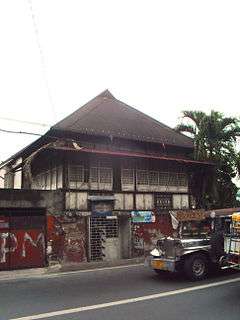
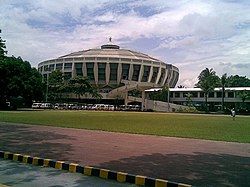
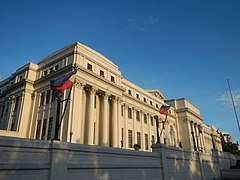
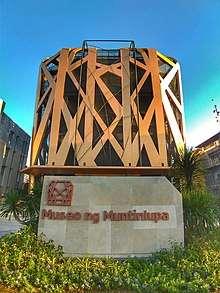

.jpg)
